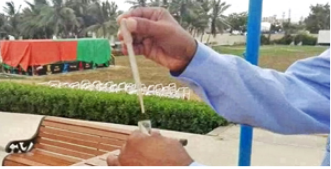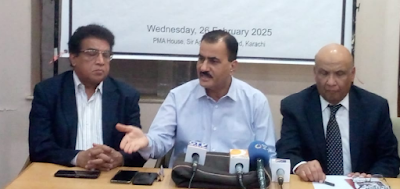Karachi reports fourth Naegleria death in 2025—but who’s keeping count?
By Mukhtar Alam
KARACHI: Karachi has now reported its fourth
death of the year attributed to Primary Amoebic Meningoencephalitis (PAM)—an
often-fatal infection caused by the brain-eating amoeba Naegleria fowleri.
The latest victim, a 17-year-old boy from North Karachi, passed away at a
private hospital on June 28. Health officials confirmed the cause and recorded
the death a day before, on June 27. What makes this case particularly troubling
is that the teenager, a student, had no known history of swimming, visiting
recreational water bodies, or even regular ablution—commonly flagged as risk
factors.
And yet, beyond the formality of
health department confirmation and a few routine updates on social media, the
public narrative barely budged. As is often the case, many journalists—myself
included—felt some closure once the official machinery had “fed the factory,”
fulfilling its bureaucratic steps. But perhaps it's worth taking a step back:
have we even confirmed all four deaths this year properly? A simple recheck of
the record—for accuracy’s sake—wouldn’t hurt. If it’s not too inconvenient, of
course.
According to health officials, the fourth Naegleria death was certified on June 28 and reported accordingly in the media. After the health department’s post, most journalists—again, myself included—moved on, assuming the boxes had been ticked. But maybe we all need to pause. Why not recount those deaths, just for the record’s sake? It would help—especially when public memory fades faster than data.
 |
| Source: Sindh Health Department |
Looking back to 2012, we know this
brain-eating amoeba tends to surface during four to five months of warmer
weather each year. That gives us a stretch of about 65 active months to date.
Doing the math, that’s an average of three deaths per month—each a grim
reminder that the problem persists. These deaths fall squarely within the
responsibility of the Sindh government. The health department’s real failing is
its inability—or unwillingness—to run a consistent, meaningful awareness
campaign.
Of course, the burden doesn’t lie with
one department alone.
Responsibility is shared—by the
Public Health Engineering Department, the Water Supply Corporation, local
bodies like the Karachi Mayor’s office and the Municipal Commissioner, the
Chief Minister’s Inspection Team, and elected representatives at every level.
Whether the water comes from an RO (Reverse Osmosis) plant or a municipal
supply line... do we even know what flaws exist? And if we don’t—shouldn’t we?
Sadly, no high-ranking official has
stepped forward to meet the bereaved families. There’s no real accountability.
No one from government circles has offered words of empathy. Human rights
advocates stay silent. Morning shows and primetime talkers ignore it largely.
Shouldn’t a death caused by
contaminated water spark something—anything?
In principle, every such death must
prompt institutional accountability. Government bodies should take
responsibility. They should offer reparations—not just in rupees, but through
action, reform, and care for the families affected. Some form of public
acknowledgment of loss. Something that says: “This life mattered.”
Instead, we get performance over
substance.
The field investigation teams seem
to follow a set script. A health awareness campaign will run on June 29 or
30—tick. No one expects more. Investigators have already implied that the
teenager’s family bears some blame: Why wasn’t the overhead tank cleaned in six
months? (Even though we all know 80% of homes, schools, and even hospitals
can’t manage that either.) So, the file is closed.
No one investigated the house. No samples were collected from the area. No scrutiny of the RO unit or the water board's supply. If investigations do happen, why do the findings never reach the public?
Meanwhile, the food watchdogs remain
busy regulating food outlets and producers. But who checks the quality of water
supplied to millions—whether from government pipelines or private tankers? Who
will finally make these bodies functional and answerable?
There used to be a committee in the
health department for Naegleria—where did it go? Once, a senior
bureaucrat’s acquaintance’s swimming pool was inspected, and the committee’s
momentum was lost.
It’s accepted that the health
department has its own share of challenges—but it should at least establish a
seasonal, designated government focal hospital for these brain-eating
infections, with proper publicity. That way, patients suffering from PAM, which
causes 99% of the fatalities, won’t have to bear the unjust burden of being
shuffled between public hospitals and private facilities.
With lab tests, ICU stays,
ventilator charges, and high fees, how can the bereaved even maintain their
dignity? Some families, after exhausting their savings at so-called private hospitals,
are left with no choice but to apply for zakat—a final indignity atop their
loss.
All of this… for water.
If only the government would take on
the cost of chlorinating the water supply with sincerity, perhaps fewer
families would be left mourning in the wake of Naegleria or other
waterborne diseases. The Sindh Healthcare Commission (SHCC) collects
significant fines—it could redirect some of that revenue to support affected
communities.
We need to think.
And perhaps this thinking—this
accountability—can be our collective sadaqah jariyah, our lasting good.
Surely, we can identify where the system is working—and where it is failing.
Surely, we can do better.
File photos: Social Track, Karachi.






It is indeed very unfortunate that people are dying from preventable diseases.
ReplyDeleteThe fourth Naegleria death in Karachi in 2025. It identifies several departments and entities responsible for the situation due to a lack of consistent public awareness campaigns, water safety measures, and accountability.